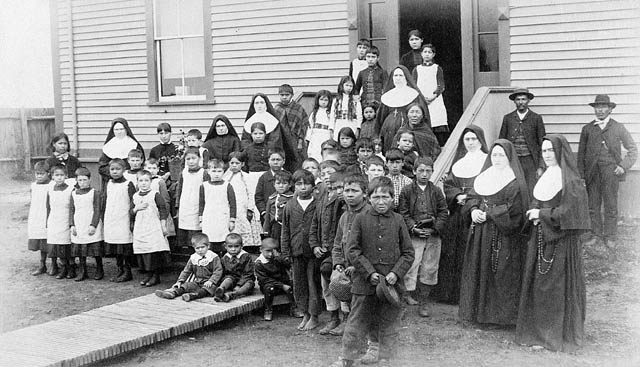At an event in May 2013, honouring residential school survivors in Williams Lake, British Columbia, the orange shirt was presented as a symbol of Indigenous peoples’ suffering caused by residential schools, which operated from the 1830s to the 1990s. The event led to the annual 30 September Orange Shirt Day as a means of remembrance, teaching and healing. In June 2021, the federal government declared 30 September a national statutory holiday to coincide with Orange Shirt Day. (See also Reconciliation in Canada.)
Residential Schools in Canada
Residential Schools were state-sponsored, church-run institutions established to assimilate Indigenous children into the dominant Canadian culture through European approaches to education and the practice of isolating the children from their families and communities. This process was traumatizing for the children and caused lasting harm to the communities from which they were taken. From the opening of the first schools in the 1830s until the last school closed in 1996, approximately 150,000 Inuit, Métis and First Nation children were forcibly removed from their homes and sent to over 130 institutions. Many children were beaten and sexually abused. In 2021, potential unmarked gravesites were discovered adjacent to a number of abandoned residential school sites. It is estimated that over 6,000 children died at the institutions.
Addressing the Legacy of the Schools
Generations of Indigenous peoples suffered the horrors and lifelong emotional damage caused by the institutions. (See also Intergenerational Trauma and Residential Schools.) Beginning in the 1980s, legal actions were taken by a number of survivors seeking compensation from the federal government. The actions evolved into the largest class action lawsuit in Canadian history. The government eventually acknowledged the damage the schools had done to Indigenous peoples and, in 2006, signed the Indian Residential Schools Settlement Agreement. Among its five main provisions was the establishment of a Truth and Reconciliation Commission. Its goal was to document what had happened at the schools, assess their lasting impacts, and make recommendations regarding how the relationship between Canada and Indigenous nations could move forward.
The federal government created the Truth and Reconciliation Commission on 1 June 2008. It was chaired by Chief Justice Murray Sinclair. Ten days later, former Prime Minister Stephen Harper rose in the House of Commons and issued an official apology, on behalf of Canadians, for residential schools. The apology was rejected by some but welcomed by many Indigenous peoples and communities. Then president of Inuit Tapiriit Kanatami, Mary Simon, was among several Indigenous leaders who had been invited to hear the apology and then respond from the floor of the House of Commons. She applauded the gesture but said it was merely a first step in a long healing process. She said, “This can only be achieved when dignity, confidence and respect for traditional values and human rights once again become part of our daily lives and are mirrored in our relationships with governments and other Canadians.”
Orange Shirt Day Begins
In May 2013, the St. Joseph Mission Commemoration Project and Reunion brought residential school survivors and their families together at Williams Lake, British Columbia. The event was the idea of Esk’etemc (Alkali Lake) Chief Fred Robbins, himself a survivor. His vision was to bring witness to the residential school experience as a way to honour survivors, help in the healing, and contribute to reconciliation.
Among those who spoke at the event was Phyllis Webstad, a Northern Secwepemc (Shuswap) woman. She said that in 1973 she was living with her grandmother on the Dog Creek Reserve, in the Fraser Valley, in central British Columbia. When she was six years old, she and her grandmother went to the local Robinson’s store to purchase a new outfit to start school. Phyllis was proud of her bright orange shirt that laced up at the front.
Like her grandmother and mother before her, Phyllis was sent to a residential school. Immediately upon arriving, she and the other kids were stripped and forced into different clothing. She never again saw the orange shirt. She later stated, “I didn’t understand why they wouldn’t give it back to me, it was mine! The colour orange has always reminded me of that and how my feelings didn’t matter, how no one cared and how I felt like I was worth nothing. All of us little children were crying, and no one cared.”
From the Williams Lake event and Phyllis Webstad’s speech came the idea to adopt the orange shirt as a symbol of remembrance, teaching and healing. The organizers of the Williams Lake Commemoration Project and Reunion initiated the formation of a board and solicited private and corporate donations. The board publicized a Canada-wide annual Orange Shirt Day as a way to invite others to join conversations about the legacy of residential schools. The 30th of September was chosen because it was the day that, for generations, Indigenous children were taken from their homes and forced into the schools. Chief Justice Murray Sinclair declared his support for Orange Shirt Day stating that it was part of the ongoing national reconciliation effort because all former residential school victims had similar stories. The message and slogan of Orange Shirt Day became Every Child Matters.
In July 2014, the Assembly of First Nations Chiefs-in-Assembly passed a resolution declaring 30 September Orange Shirt Day. It committed members to raising awareness of the day and its message. The resolution asked all Canadians to listen “with open hearts” to the stories of residential school survivors as “a first step in reconciliation.”
Part of the Orange Shirt Day effort saw the First Nations Education Steering Committee develop grade 5 and 10 curricula to teach children about residential schools and reconciliation. It was first adopted by Cariboo-Chilcotin School District 27 in 2013 and later throughout British Columbia. By 30 September 2020, Orange Shirt Day ideas and resources were used by teachers across Canada, and the day was commemorated by students wearing orange in schools, colleges and universities nationwide.
The National Holiday
The Truth and Reconciliation Commission issued its report in December 2015. It stated that residential schools represented cultural genocide. It stated 94 Calls to Action, and among them was the establishment of a national holiday to commemorate the horrors of the schools and to help in healing. (See also Genocide and Indigenous Peoples in Canada.)
In March 2019, the House of Commons passed a bill designating 30 September as an annual National Truth and Reconciliation Day. However, an election was called before the bill passed the Senate.
In May 2021, 215 potential unmarked graves were discovered beside an old residential school at the Tk'emlúps te Secwépemc First Nation, near Kamloops, British Columbia. In subsequent weeks, more potential unmarked graves were found beside other abandoned residential schools. The grisly discoveries renewed calls for an accounting, reconciliation and a national holiday.
On 3 June 2021, after unanimous passage in the House of Commons, Bill C-5 was unanimously passed in the Senate. The Bill created 30 September as a new national statutory holiday: National Day for Truth and Reconciliation. In moving the bill, Canadian Heritage Minister Steven Guilbeault said that he hoped the day would become, like Remembrance Day, an opportunity for all to learn and reflect.
While plans were made to close all federal offices on 30 September 2021 for the first National Day for Truth and Reconciliation in Canada, the governments of Ontario, Saskatchewan, New Brunswick, Quebec and Alberta announced that they would not recognize the day as provincial statutory holidays. As of 2024, New Brunswick, British Columbia, Prince Edward Island, Manitoba, the Northwest Territories, Nunavut, and Yukon all declared the National Day for Truth and Reconciliation a statutory holiday.

 Share on Facebook
Share on Facebook Share on X
Share on X Share by Email
Share by Email Share on Google Classroom
Share on Google Classroom









.jpg)






